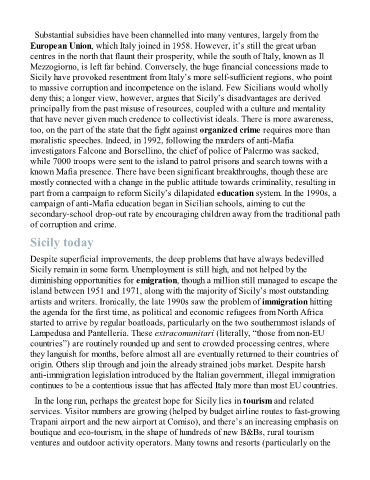Page 574 - The Rough Guide of Sicily
P. 574
Substantial subsidies have been channelled into many ventures, largely from the
European Union, which Italy joined in 1958. However, it’s still the great urban
centres in the north that flaunt their prosperity, while the south of Italy, known as Il
Mezzogiorno, is left far behind. Conversely, the huge financial concessions made to
Sicily have provoked resentment from Italy’s more self-sufficient regions, who point
to massive corruption and incompetence on the island. Few Sicilians would wholly
deny this; a longer view, however, argues that Sicily’s disadvantages are derived
principally from the past misuse of resources, coupled with a culture and mentality
that have never given much credence to collectivist ideals. There is more awareness,
too, on the part of the state that the fight against organized crime requires more than
moralistic speeches. Indeed, in 1992, following the murders of anti-Mafia
investigators Falcone and Borsellino, the chief of police of Palermo was sacked,
while 7000 troops were sent to the island to patrol prisons and search towns with a
known Mafia presence. There have been significant breakthroughs, though these are
mostly connected with a change in the public attitude towards criminality, resulting in
part from a campaign to reform Sicily’s dilapidated education system. In the 1990s, a
campaign of anti-Mafia education began in Sicilian schools, aiming to cut the
secondary-school drop-out rate by encouraging children away from the traditional path
of corruption and crime.
Sicily today
Despite superficial improvements, the deep problems that have always bedevilled
Sicily remain in some form. Unemployment is still high, and not helped by the
diminishing opportunities for emigration, though a million still managed to escape the
island between 1951 and 1971, along with the majority of Sicily’s most outstanding
artists and writers. Ironically, the late 1990s saw the problem of immigration hitting
the agenda for the first time, as political and economic refugees from North Africa
started to arrive by regular boatloads, particularly on the two southernmost islands of
Lampedusa and Pantelleria. These extracomunitari (literally, “those from non-EU
countries”) are routinely rounded up and sent to crowded processing centres, where
they languish for months, before almost all are eventually returned to their countries of
origin. Others slip through and join the already strained jobs market. Despite harsh
anti-immigration legislation introduced by the Italian government, illegal immigration
continues to be a contentious issue that has affected Italy more than most EU countries.
In the long run, perhaps the greatest hope for Sicily lies in tourism and related
services. Visitor numbers are growing (helped by budget airline routes to fast-growing
Trapani airport and the new airport at Comiso), and there’s an increasing emphasis on
boutique and eco-tourism, in the shape of hundreds of new B&Bs, rural tourism
ventures and outdoor activity operators. Many towns and resorts (particularly on the

